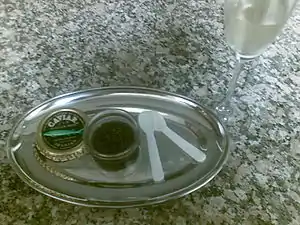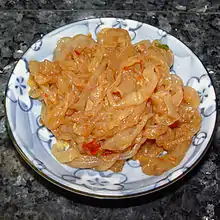Delicacy
A delicacy is usually a rare or expensive food item that is considered highly desirable, sophisticated or peculiarly distinctive, within a given culture. Irrespective of local preferences, such a label is typically pervasive throughout a region. Often this is because of unusual flavors or characteristics or because it is rare or expensive compared to standard staple foods.



Delicacies vary per different countries, customs and ages. Flamingo tongue was a highly prized dish in ancient Rome, but is not commonly eaten in modern times. Lobsters were considered poverty food in North America until the mid-19th century[1] when they started being treated, as they were in Europe, as a delicacy. Some delicacies are confined to a certain culture, such as fugu in Japan, bird's nest soup (made out of swiftlet nests) in China, and ant larvae (escamoles) in Mexico or refer to specific local products, such as porcino, venison or anchovy.
Examples of delicacies
- Abalone (Bao Yu) – China, Japan[2][3][4]
- Akutaq – Alaska, Northern Canada, Siberia[5]
- Alligator meat - Southern United States
- Alici from the Gulf of Trieste near Barcola - Italy[6]
- Balut – Southeast Asia[7]
- Biltong – Southern Africa
- Bird's nest soup – China[8]
- Black-headed gull eggs – United Kingdom[9][10]
- Bottarga – Mediterranean Basin
- Bourbon - Kentucky, Louisiana
- Casu marzu – Sardinia[7]
- Caviar – Russia, Iran[11][12]
- Cempedak – Indonesia, Malaysia, Southern Thailand
- Champagne – Champagne region of France
- Conpoy – China[13]
- Droëwors – Southern Africa
- Durian – Borneo, Sumatra[14]
- Escamol – Mexico City[7]
- Escargot – France[15][16]
- Filet mignon – France
- Foie gras – Périgord region of France[17]
- Fried-brain sandwich – Indiana, Ohio, St. Louis[7]
- Fried tarantula – Skuon[7]
- Fugu – Japan[18][19]
- Gyromitra esculenta – Scandinavia
- Guinea pig – Bolivia, Colombia, Ecuador, Peru[20][21]
- Haggis – Scotland[22]
- Hákarl – Iceland[23]
- Huitlacoche – Mexico[7]
- Iberian ham (Jamón ibérico) – Spain, Portugal[24][25]
- Ikizukuri – Japan
- Edible jellyfish – East Asia, Southeast Asia[26]
- Karasumi – Japan, Taiwan[27][28]
- Kiviak – Greenland[7]
- Kobe beef – Hyōgo[29]
- Kopi luwak – Indonesia[30][31]
- Lobster – Maine, Massachusetts, New York City, The Maritimes[1]
- Moonshine - Scotland, Ireland, Appalachia
- Ortolan bunting – France[17]:34
- Raw oysters – Malaysia, France, United States[32]
- Quail eggs, including pickled quail eggs – Brazil, Colombia, Denmark, Ecuador, Indonesia, Japan, Philippines, South Korea, Venezuela, Vietnam[33][34]
- Rocky Mountain oysters – Argentina, Canada, Mexico, Spain, United States[35][36]
- Scallops;[37] their roes, called corals, are also a delicacy.[38][39] – Galicia, Japan, Taiwan
- Sea cucumber – East Asia, Southeast Asia[40][41]
- Shark fin soup - China[42]
- Shiokara – Japan[7]
- Shirako (milt) – Indonesia, Japan, Korea, Romania, Russia, Sicily[7]
- Smalahove – Western Norway[7]
- Snail caviar[43]
- Snake soup – Guangdong, Hong Kong[44] – Austria, France, United Kingdom, United States
- Surströmming – Sweden[45][46]
- Truffle – Caucasus, Middle East, Southern Europe[47]
- Tyrolean grey cheese – Austria
See also
- Acquired taste
- Chinmi – Includes a list of Japanese delicacies
- Delicatessen
- Shaxian delicacies – a style of cuisine from Sha County, Sanming, Fujian, China
- Specialty foods
References
- Kraynak, J.; Tetrault, K.W. (2003). The Complete Idiot's Guide to the Oceans. Complete Idiot's Guide to. Alpha Books. p. 157. ISBN 978-0-02-864462-2. Retrieved 31 January 2015.
- Vos, H. (2010). Passion of a Foodie - An International Kitchen Companion. Strategic Book Publishing & Rights Agency (SBPRA). p. 12. ISBN 978-1-934925-63-8. Retrieved 31 January 2015.
- Bestor, T.C. (2004). Tsukiji: The Fish Market at the Center of the World. California Studies in Food and Culture. University of California Press. p. 166. ISBN 978-0-520-92358-4. Retrieved 31 January 2015.
- Chen, T.M.; Yan, M. (2009). A Tradition of Soup: Flavors from China's Pearl River Delta. North Atlantic Books. ISBN 978-1-55643-765-6. Retrieved 31 January 2015.
- National Geographic, Volume 165. National Geographic Society. 1984. Retrieved 31 January 2015. ISSN 1044-6613
- Georges Desrues "Eine Lange Nacht am Meer", In: Triest - Servus Magazin (2020), p 73.
- Gale, Hannah (30 June 2014). "These 15 food delicacies from around the world will make you gag". Metro. Retrieved 31 January 2015.
- Hopkins, J.; Bourdain, A.; Freeman, M. (2004). Extreme Cuisine: The Weird & Wonderful Foods that People Eat. Periplus Editions (HK) Limited. ISBN 978-0-7946-0255-0. Retrieved 31 January 2015.
- Copping, Jasper (28 March 2009). "Top restaurants face shortage of seagull eggs". Telegraph.co.uk. Retrieved 31 January 2015.
- Behaviour : an International Journal of Comparative Ethology: Supplement. Behaviour : an International Journal of Comparative Ethology: Supplement. E.J. Brill. 1964. p. 66. Retrieved 31 January 2015. ISSN 0169-7544. Quote: "Black-headed gulls eggs" have been, and still are, renowned as a delicacy".
- Caviar with Champagne: Common Luxury and the Ideals of the Good Life in ... - Jukka Gronow. p. 31.
- "Caviar", in Encyclopædia Iranica online. Accessed June 2010.
- Hsiung, D.T.; Hom, K. (2002). The Chinese Kitchen: A Book of Essential Ingredients with Over 200 Easy and Authentic Recipes. St. Martin's Press. ISBN 978-0-312-28894-5. Retrieved 31 January 2015.
- Contis, E.T.; Ho, C.T.; Mussinan, C.J.; Parliment, T.H.; Shahidi, F.; Spanier, A.M. (1998). Food Flavors: Formation, Analysis and Packaging Influences: Formation, Analysis and Packaging Influences. Developments in Food Science. Elsevier Science. ISBN 978-0-08-053183-0. Retrieved 31 January 2015.
- Wheeler, E.J. (1903). Current Literature. American periodical series, 1850-1900. Current Literature Publishing Company. p. 760. Retrieved 31 January 2015.
- Koeller, K.; France, R.L.; Fasano, A. (2013). Let's Eat Out Around the World Gluten Free and Allergy Free, Fourth Edition: Eat Safely in Any Restaurant at Home or Abroad. Bibliothèque numérique canadienne: Collection des éditeurs canadiens. Demos Medical Publishing. ISBN 978-1-61705-204-0. Retrieved 31 January 2015.
- The Foie Gras Wars: How a 5,000-Year-Old Delicacy Inspired the World's ... - Mark Caro
- Karleskint, G.; Turner, R.; Small, J. (2012). Introduction to Marine Biology. Cengage Learning. p. 277. ISBN 978-1-285-40222-2. Retrieved 31 January 2015.
- Publishing, DK (2010). The Illustrated Cook's Book of Ingredients. The Illustrated Cook's Book of Ingredients. DK Publishing. p. 45. ISBN 978-0-7566-7673-5. Retrieved 31 January 2015.
- London, J.W.P.L.A.L.U.C. (2009). The Andes. LANDSCAPES OF IMAGINATION. Oxford University Press, USA. p. 156. ISBN 978-0-19-973107-7. Retrieved 31 January 2015.
- Clemons, D.J.; Seeman, J.L. (2011). The Laboratory Guinea Pig, Second Edition. Laboratory Animal Pocket Reference. Taylor & Francis. p. 1. ISBN 978-1-4398-3556-2. Retrieved 31 January 2015.
- Dendinger, R.; Gritzner, C.F. (2009). Scotland. Modern World Nations Series. Facts On File, Incorporated. p. 41. ISBN 978-1-4381-0538-3. Retrieved 31 January 2015.
- Herz, Rachel (28 January 2012). "You eat that?". Wall Street Journal. Retrieved 28 August 2015.
- Von Bremzen, A.; Goldman, S. (2005). The New Spanish Table. Workman Publishing. p. 237. ISBN 978-0-7611-3555-5. Retrieved 31 January 2015.
- Mullen, S. (2012). Seamus Mullen's Hero Food: How Cooking with Delicious Things Can Make Us Feel Better. Andrews McMeel Publishing, LLC. ISBN 978-1-4494-0780-3. Retrieved 31 January 2015.
- Fraioli, J.O.; Sato, K. (2008). The Complete Idiot's Guide to Sushi and Sashimi. Complete Idiot's Guide to. Alpha. p. 9. ISBN 978-1-59257-782-8.
- Balla, N.; Burns, C.; Newberry, J.; Robertson, C. (2014). Bar Tartine: Techniques and Recipes. Chronicle Books LLC. p. 62. ISBN 978-1-4521-3235-8. Retrieved 31 January 2015.
- Free China Review. W.Y. Tsao. 1970. p. 8. Retrieved 31 January 2015.
- DK Eyewitness Travel Guide: Japan - John Turp. p. 323.
- D, J.D.P.; Murakhver, N. (2012). They Eat That?: A Cultural Encyclopedia of Weird and Exotic Food from Around the World. ABC-CLIO. ISBN 978-0-313-38058-7. Retrieved 31 January 2015.
- Eden, B.L. (2008). Content Management Systems in Libraries: Case Studies. Scarecrow Press. ISBN 978-0-8108-5692-9. Retrieved 31 January 2015.
- Ortega, G.P.; Musser, J. (2012). From the Family Kitchen: Discover Your Food Heritage and Preserve Favorite Recipes. F+W Media. ISBN 978-1-4403-1833-7. Retrieved 31 January 2015.
- Trang, C. (1999). Authentic Vietnamese Cooking: Food from a Family Table. Verve Editions. p. 192. ISBN 978-0-684-86444-0. Retrieved 31 January 2015.
- Drowns, G. (2012). Storey's Guide to Raising Poultry: Chickens, Turkeys, Ducks, Geese, Guineas, Gamebirds. Storey's guide to raising series. Storey Pub. p. 225. ISBN 978-1-61212-000-3. Retrieved 31 January 2015.
- Planet, L. (2011). Lonely Planet Best Rocky Mountain Trips: 9 Trips from USA's Best Trips Travel Guide. Travel Guide. Lonely Planet Publications. ISBN 978-1-74220-917-3. Retrieved 31 January 2015.
- Florence, M.; Gierlich, M.; Nystrom, A.D. (2001). Rocky Mountains. LONELY PLANET ROCKY MOUNTAINS (in Czech). Lonely Planet. ISBN 978-1-86450-327-2. Retrieved 31 January 2015.
- New International Encyclopedia. New International Encyclopedia. Dodd, Mead. 1916. p. 514. Retrieved 31 January 2015.
- Westmoreland, S.; Goldsmith, S.D.; Burge, E.B. (2008). Good Housekeeping Step by Step Cookbook. Good Housekeeping Step-By-Step. Hearst Books. p. 89. ISBN 978-1-58816-760-6. Retrieved 31 January 2015.
- Green, A.; Legato, S. (2011). The Fishmonger's Apprentice: The Expert's Guide to Selecting, Preparing, and Cooking a World of Seafood, Taught by the Masters. Apprentice. Quarry Books. p. 144. ISBN 978-1-61059-470-7. Retrieved 31 January 2015.
- Yang, H.; Hamel, J.F.; Mercier, A. (2015). The Sea Cucumber Apostichopus japonicus: History, Biology and Aquaculture. Developments in Aquaculture and Fisheries Science. Elsevier Science. p. 15. ISBN 978-0-12-800467-8. Retrieved 31 January 2015.
- Lovatelli, A.; Conand, C. (2004). Advances in Sea Cucumber Aquaculture and Management. Advances in sea cucumber aquaculture and management. Food and Agriculture Organization of the United Nations. p. 58. ISBN 978-92-5-105163-4. Retrieved 31 January 2015.
- "What is Shark Fin Soup?". Shark Allies. Retrieved 27 November 2020.
- "Ingredient Spotlight: Snails". guide.michelin.com. 25 February 2019. Retrieved 8 September 2020.
- "'Weird foods to eat in Hong Kong...'". Eating Adventures. 1 August 2017. Retrieved 17 April 2018.
- Bell, R. (2005). How Swede It Is. Lulu Enterprises Incorporated. ISBN 978-1-4116-6025-0. Retrieved 31 January 2015.
- Saberi, H. (2011). Cured, Smoked, and Fermented: Proceedings of the Oxford Symposium on Food and Cooking, 2011. Proceedings of the Oxford Symposium on Food and Cookery. Prospect Books. ISBN 978-1-903018-85-9. Retrieved 31 January 2015.
- The Gardener's Magazine and Register of Rural & Domestic Improvement. p. 397.
Further reading
- 王艳芳 (9 August 2011). "Top 13 most disgusting delicacies in the world". China.org.cn. Retrieved 31 January 2015.
- Miller, Michael (22 September 2006). "Strange foods". AskMen. Retrieved 31 January 2015.
- Ortile, Matt (24 July 2013). "23 Unexpected Cultural Delicacies From Asia". BuzzFeed. Retrieved 31 January 2015.
- Bercovici, Jeff (5 August 2011). "The World's Most Disgusting Delicacies". Forbes. Retrieved 31 January 2015.
External links
| Wikimedia Commons has media related to Delicatessens. |
| Wikiquote has quotations related to: Delicacy |
| Look up delicacy in Wiktionary, the free dictionary. |
